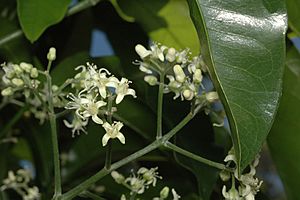Doughwood facts for kids
Quick facts for kids Doughwood |
|
|---|---|
 |
|
| Acronychia octandra in Mount Coot-tha Botanic Gardens | |
| Scientific classification | |
| Genus: |
Acronychia
|
| Species: |
octandra
|
The Doughwood (scientific name: Acronychia octandra) is a type of rainforest tree. It is also known by other names like silver birch or soapwood. This tree is found only in the eastern coastal areas of Australia.
Doughwood trees usually have leaves made of three smaller leaflets. Their flowers are greenish-white and grow in groups where the leaves meet the stem. The tree also produces a fleshy fruit with four parts joined at the bottom.
Contents
What Does Doughwood Look Like?
Doughwood trees can grow quite tall, sometimes reaching up to 27 meters (about 89 feet) high.
Most of their leaves are trifoliate, meaning they have three leaflets. These leaflets are shaped like a narrow oval or egg, usually 80–220 mm (3–9 inches) long and 20–80 mm (1–3 inches) wide. The main leaf stalk is 20–80 mm (1–3 inches) long, but the smaller stalks for each leaflet are very short or missing.
The flowers grow in small clusters that are 5–24 mm (0.2–0.9 inches) long. Each flower sits on a tiny stalk about 3–6 mm (0.1–0.2 inches) long. They have four small green parts called sepals, which are 1–2 mm wide. There are also four greenish-white petals, about 6–8 mm (0.2–0.3 inches) long. Inside the flower, there are eight stamens, which are the parts that produce pollen, and they are different lengths.
Doughwood trees usually flower from December to April. After flowering, they produce a fleshy fruit. This fruit is made of four parts that are joined together at the base. Each part of the fruit is oval or elliptical and about 3–3.5 mm (0.12–0.14 inches) long.
How Doughwood Got Its Name
The Doughwood tree was first officially described in 1860 by a scientist named Ferdinand von Mueller. He first called it Euodia octandra. He wrote about it in his book Fragmenta phytographiae Australiae, using samples collected near the Clarence River.
Later, in 1991, another scientist, Thomas Gordon Hartley, changed its name to Acronychia octandra in a scientific journal called Australian Systematic Botany. The word octandra in its scientific name refers to the eight stamens found in its flowers.
Where Doughwood Grows
Doughwood trees grow in warm, wet areas, both in subtropical and warm-temperate climates. You can find them from sea level up to about 900 meters (about 2,950 feet) high.
Their natural home stretches from the McPherson Range in south-east Queensland down to the area near the Clarence River in New South Wales.
Growing Doughwood Trees
If you plant fresh Doughwood seeds, they can sprout very quickly, sometimes in as little as 11 days! However, some seeds might take much longer to germinate, even up to five months after they are planted.
Images for kids
See also
 In Spanish: Melicope para niños
In Spanish: Melicope para niños





